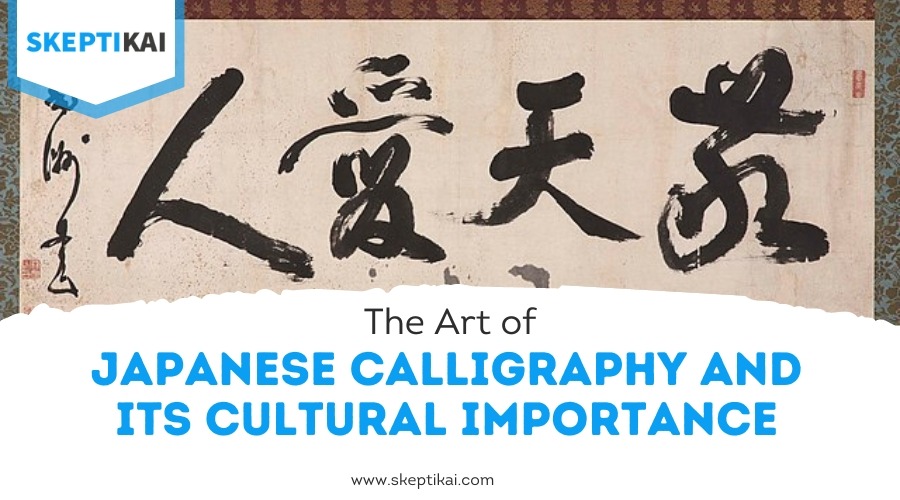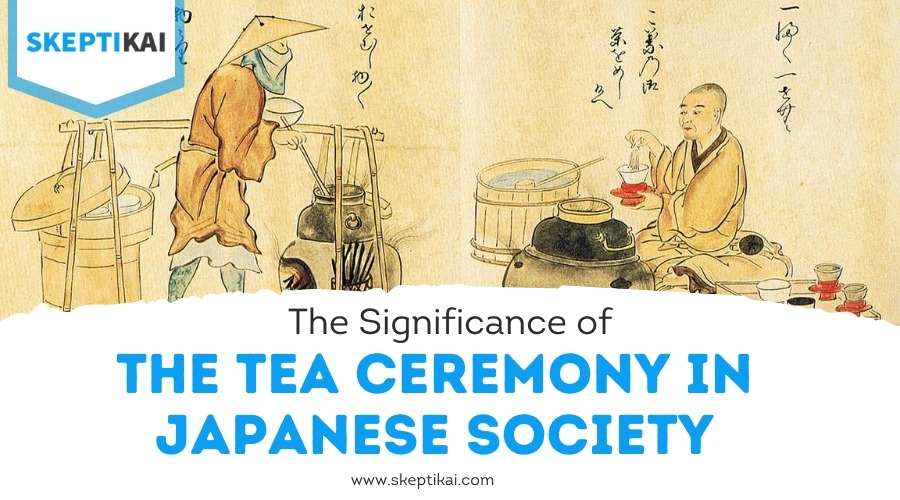Which Aspect of Japanese Culture Influenced Western Culture in the Late 1800S?

In the late 1800s, Japanese culture greatly influenced Western art, architecture, and philosophy. You'll notice Japanese Ukiyo-e prints captivated Western artists, affecting Impressionism with their bold colors and unique compositions. Japanese architecture introduced minimalism, using natural materials and open spaces, reshaping Western design. The philosophy of wabi-sabi, celebrating imperfection and the transient nature of life, also gained traction. Even Western fashion welcomed the kimono, transforming silhouettes and patterns. Furthermore, Japanese theater and literature added narrative depth and artistic expression to Western counterparts. Uncover more about how these elements intertwined and transformed Western culture during this intriguing period.
Japanese Ukiyo-e Prints
Among the many intriguing aspects of Japanese culture, Ukiyo-e prints have had a significant impact on Western art and design. As you investigate these enchanting artworks, you'll uncover how their unique blend of Ukiyo-e symbolism and artistic techniques captured the imagination of Western artists. Ukiyo-e, which means "pictures of the floating world," often depicted scenes of nature, kabuki actors, and beautiful women. These prints were rich in symbolism, with elements like cherry blossoms representing the transient nature of life, or koi fish symbolizing perseverance and strength. The influence of Japanese creators, both in Ukiyo-e and contemporary forms like anime and manga, showcases the enduring impact of Japanese art on global creativity. When you scrutinize the artistic techniques used in Ukiyo-e, you'll notice a distinctive approach to composition, color, and line work. Artists employed bold outlines and flat areas of color, creating a sense of depth and movement without relying on traditional Western perspective. This method offered a fresh visual language that intrigued and inspired Western artists who were hungry for new ideas. Furthermore, the careful woodblock printing techniques allowed for lively and detailed reproductions, making Ukiyo-e prints accessible to a wide audience.
Influence on Impressionism

As you examine the enchanting world of Ukiyo-e prints, you'll find their influence extends far beyond Japan and leaves a lasting impression on Western art movements, particularly Impressionism. These Japanese artworks, with their lively colors and unique perspectives, captivated Western artists like Claude Monet and Edgar Degas. Ukiyo-e prints introduced groundbreaking color theory, emphasizing bold contrasts and flat areas of color instead of the traditional Western focus on shading and depth. This approach encouraged Impressionists to investigate new ways of using color to capture light and atmosphere in their paintings. Likewise, the evolution of Japanese cuisine from sushi to ramen demonstrates how traditional Japanese elements have been adapted and appreciated globally. The compositional techniques of Ukiyo-e also had a profound impact. The prints often featured asymmetrical layouts and cropped views, offering fresh perspectives that broke away from the rigid compositional rules of Western art. Impressionists adopted these techniques, using them to create dynamic and spontaneous compositions that reflected modern life. By incorporating these elements, they could convey a sense of movement and immediacy in their work.
Japanese Architecture Styles
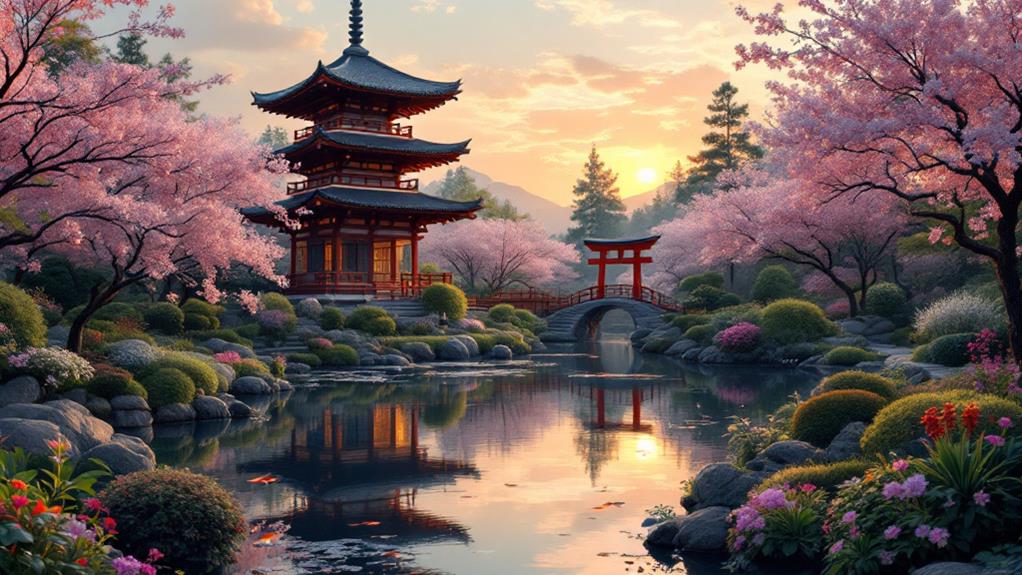
Japanese architecture has considerably influenced Western architectural styles, incorporating elements that balance simplicity with functionality. You might notice this influence in the way spaces are designed to evoke tranquility and harmony. The Shinto aesthetics emphasize a connection with nature, using natural materials like wood and stone to create an organic feel. In Western architecture, this has translated into a focus on sustainable materials and open spaces that invite the outdoors inside.
Zen minimalism has also left its mark, promoting uncluttered environments that encourage peace and mindfulness. You can see this in the clean lines and minimal decorations that prioritize purpose over excess. Here are some elements of Japanese architecture that evoke deep emotions:
- Serenity: The calmness of a Japanese garden or the simplicity of a Zen rock garden.
- Balance: The harmonious blend of natural and man-made structures.
- Connection: The seamless integration of indoor and outdoor spaces.
- Mindfulness: Spaces that invite reflection and contemplation.
Impact on Western Fashion
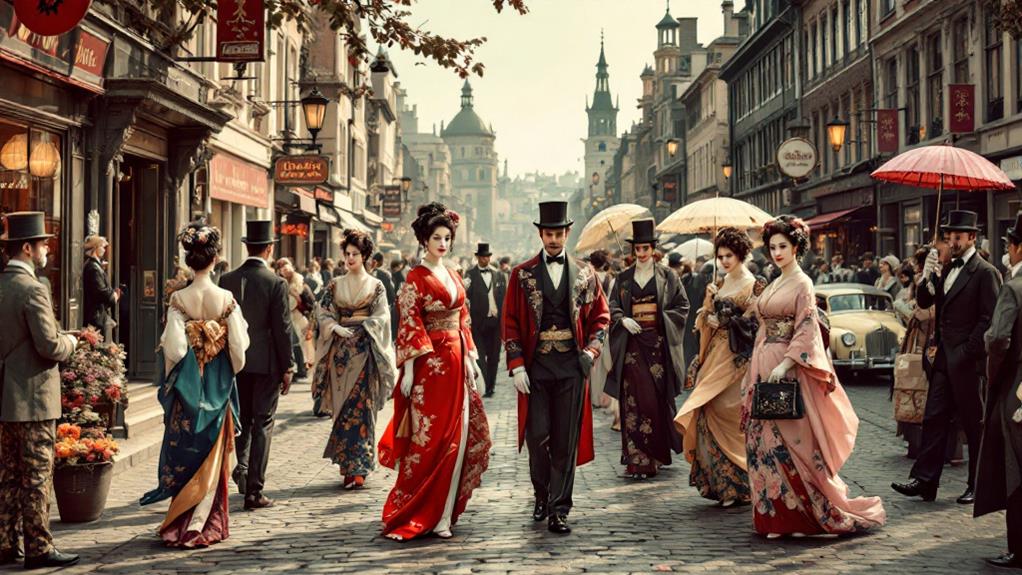
Influencing Western fashion in subtle yet profound ways, Japanese culture has introduced elements that redefine style and aesthetics. As you investigate this fascinating cross-cultural exchange, you'll uncover how the traditional kimono inspired Western designers. Kimono adaptations began appearing in Western wardrobes, characterized by loose silhouettes and flowing fabrics. These garments brought a fresh perspective to Western fashion, emphasizing comfort and elegance over structured forms.
Western tailors, enthusiastic to incorporate these exotic elements, started experimenting with Japanese-inspired designs. They integrated bold patterns, wide sleeves, and intricate embroidery, which added a distinct flair to traditional Western attire. This blend of styles didn't just stop at clothing; it also influenced accessories and textiles, with Japanese motifs becoming fashionable in scarves, belts, and even home decor.
You can see the impact of Japanese style in the work of prominent designers of that period, who welcomed these influences and pushed the boundaries of Western fashion norms. By adopting Japanese aesthetics, Western fashion evolved into something more expressive and diverse. This cultural infusion allowed for a richer tapestry of fashion that resonated with a growing desire for unique, international influences in everyday attire.
Philosophy of Wabi-Sabi
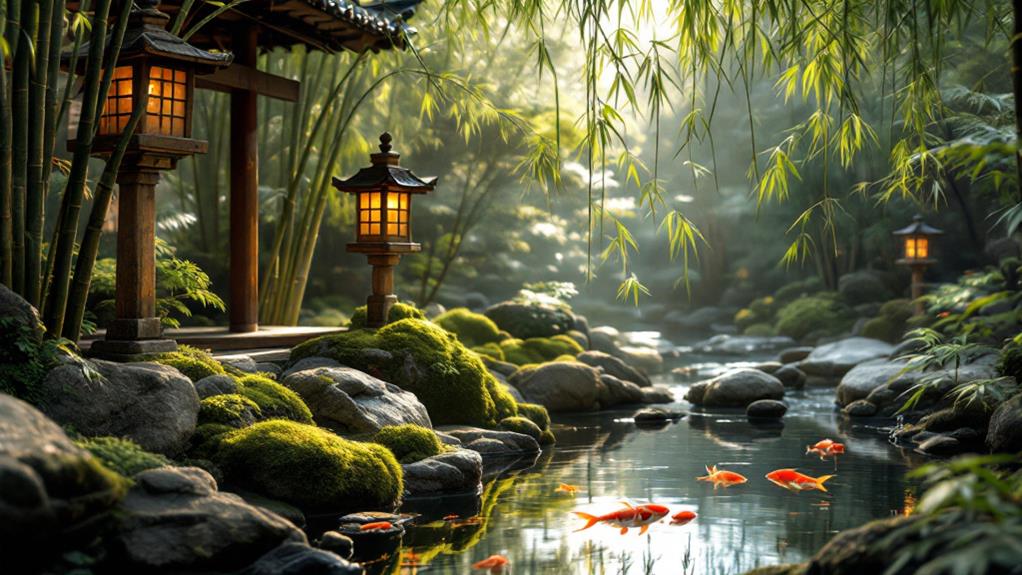
In a world that often chases perfection, the philosophy of wabi-sabi offers an invigorating perspective by celebrating imperfection and transience. You find beauty in the fleeting, seeing value in the incomplete and the worn. Wabi sabi aesthetics invite you to welcome a world where everything is in a constant state of becoming and fading. This Japanese philosophy influenced Western culture in the late 1800s, encouraging a shift from rigid ideals to appreciating life's evanescent charm.
Imagine walking through a garden as autumn leaves fall, each one a masterpiece of transient beauty. You notice:
- A weathered, hand-carved bench, its surface marked by time.
- A delicate wildflower growing between stones, resilient yet ephemeral.
- An old, cherished book with yellowing pages, whispering stories of the past.
- A humble teacup, cracked and mended, telling tales of shared moments.
These elements evoke a sense of peace and acceptance. The West began to see that beauty doesn't always come from symmetry or flawlessness. Instead, it might lie in the stories etched into an object's surface, the memories they hold, and the quiet lessons they teach about life's impermanence.
Japanese Ceramic Techniques

Stepping into the world of Japanese ceramics, you quickly uncover the rich history and intricate techniques that have shaped this art form. One of the most fascinating techniques is Raku pottery, known for its unique firing process and the serendipitous beauty it yields. As you investigate Raku, you'll notice how each piece is a representation of the unpredictable nature of fire and glaze, creating stunning, one-of-a-kind results. This approach celebrates imperfections and spontaneity, embodying the essence of Wabi-Sabi.
Another remarkable technique is Kintsugi art, where broken pottery is repaired using lacquer mixed with powdered gold, silver, or platinum. Rather than hiding the damage, Kintsugi highlights the cracks and joins, transforming them into beautiful features. You might find this philosophy of embracing flaws and turning them into something more intriguing has resonated deeply with Western artists and thinkers, who see beauty in imperfection.
In the late 1800s, these techniques influenced Western ceramics, encouraging artists to experiment with new forms and ideas. By embracing Japanese ceramic techniques, you can appreciate how this cultural exchange enriched Western art, fostering a deeper appreciation for beauty in imperfection and uniqueness.
Japanese Gardens Inspiration
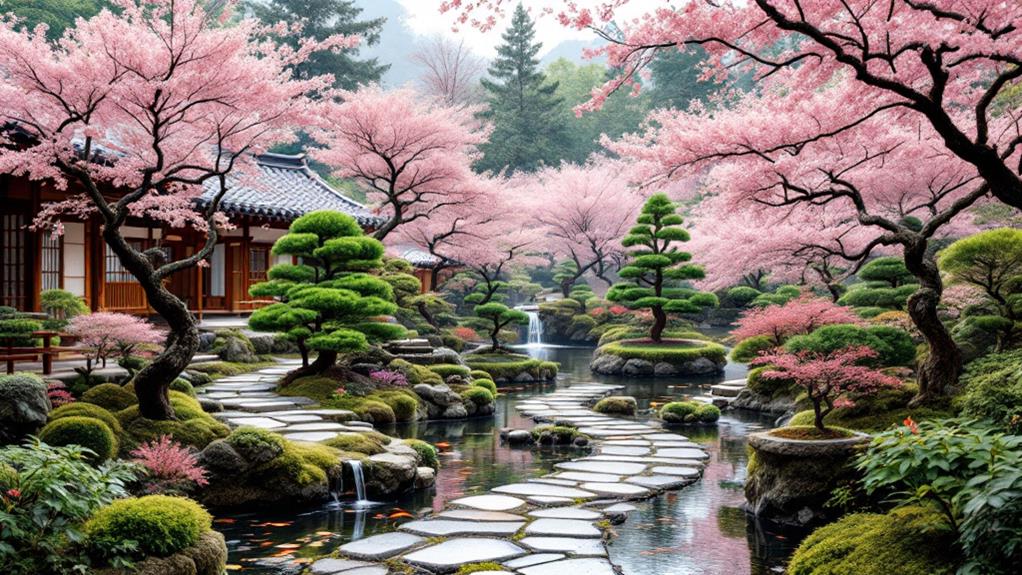
As you admire the artistry of Japanese ceramics, it's natural to investigate how Japanese aesthetics further extend into the domain of garden design. Japanese gardens have profoundly influenced Western culture, especially in the late 1800s, when the allure of Zen aesthetics and garden symbolism captivated the imagination. These gardens are not just spaces filled with plants and stones; they're designed to evoke deep emotions and reflection.
In your exploration of Japanese garden inspiration, you'll uncover:
- Peace: The tranquility of a Zen garden, where carefully raked gravel symbolizes water, and rocks represent mountains, invites introspection and calm.
- Harmony: The seamless blend of natural and human-made elements fosters a sense of unity and balance, urging you to find harmony in your own life.
- Simplicity: The minimalistic approach, where less is more, teaches you to appreciate the beauty of simplicity and the power of subtlety.
- Symbolism: Every element, from a stone lantern to a koi pond, carries deeper meanings, encouraging you to ponder your own life's symbolism.
As you incorporate these Japanese garden ideals, you'll find the serenity and depth they bring to your own environment, enhancing your appreciation for nature's quiet elegance.
Influence on Graphic Design

Japanese culture has seamlessly seeped into the domain of graphic design, leaving an indelible mark on Western aesthetics. As you investigate the intricacies of graphic design in the late 1800s, you'll notice how Japanese art transformed Western printmaking. The influence is evident in the use of asymmetrical compositions, which broke away from the rigid structures of European art. You can see this shift in the works of artists like Whistler and Van Gogh, who adopted these new forms.
Japanese color palettes, characterized by their subtlety and harmony, also played a significant role. Western designers started incorporating these unique color schemes into their works, moving away from the bold and contrasting colors that were previously popular. This introduction of muted tones, inspired by Japanese prints, added a new dimension to Western design, creating a more serene and balanced visual experience.
Additionally, the emphasis on simplicity and minimalism in Japanese art encouraged Western designers to strip away unnecessary elements and focus on the core message. This approach to design not only influenced printmaking but also laid the groundwork for modern graphic design principles you recognize today.
Role of Japanese Theater
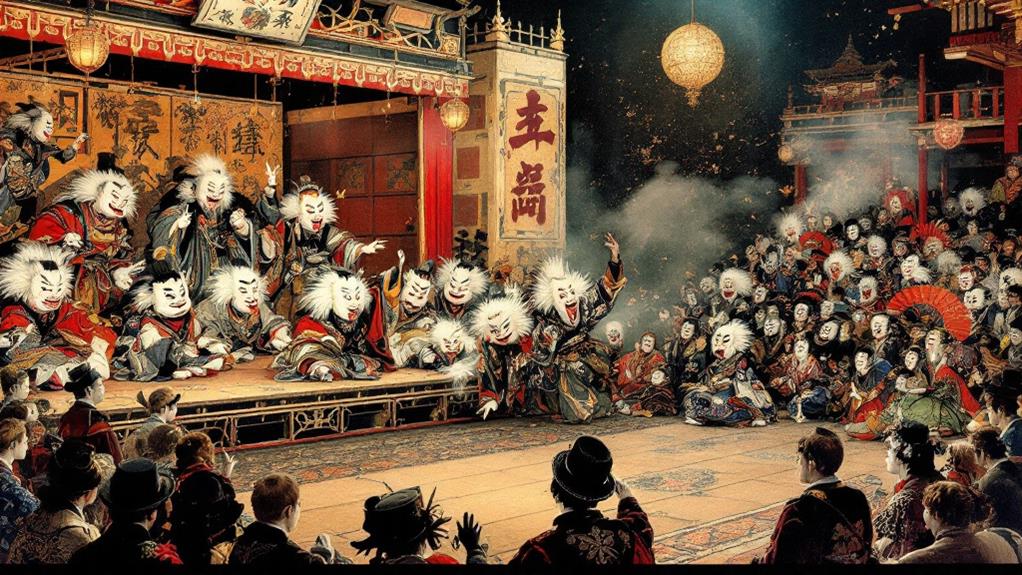
One of the most enchanting aspects of Japanese culture that has influenced the West is its theater, particularly the traditional forms of Noh, Kabuki, and Bunraku. Imagine the sheer power of Kabuki performances, where lively costumes and dramatic expressions captivate your senses. The West was mesmerized by these theatrical spectacles, leading to a fascination with Japanese aesthetics and storytelling.
Noh theater, with its minimalist stage and slow, deliberate movements, offers a stark contrast that's just as compelling. It's not just about entertainment; it's about conveying deep emotions and spiritual themes. Western playwrights and directors found inspiration in these aspects, incorporating the rich symbolism and unique narrative techniques into their own works.
Consider how you would feel witnessing:
- The poignant silence of a Noh performance, where every pause speaks volumes.
- The lively energy of Kabuki, with its exaggerated gestures and vibrant music.
- The intricate puppetry of Bunraku, where each movement is a dance of precision.
- The ancient stories that transcend time, leaving you pondering their meaning.
These traditional forms of Japanese theater opened up new artistic avenues in the West, forever altering the landscape of Western performing arts and storytelling.
Japanese Literature Translations

Imagine picking up a book and stepping into a world crafted by a Japanese author, whose words have been elegantly translated for your enjoyment. During the Meiji Period, Western audiences began to investigate Japanese literature, drawn by its unique literary themes and narrative styles. This cultural exchange introduced readers to aesthetic values and philosophies previously unfamiliar to them. The challenge of translation involved maintaining the author's original intent and the cultural nuances that shaped the stories, often a formidable task for translators.
You'd notice how Japanese narrative styles, rich in symbolism and subtlety, influenced Western adaptations. Authors and translators worked to preserve these elements, ensuring that the translated works retained their depth and complexity. As a result, Western writers began to incorporate these influences into their own works, blending Eastern and Western literary traditions.
The translation process itself was rife with challenges. It required not only linguistic skill but also a deep understanding of Japanese culture to accurately convey the author's influences and intentions. This period of cultural exchange greatly impacted Western literature, inspiring authors to investigate new themes and accept different aesthetic values, enriching the literary landscape of the late 1800s and beyond.

